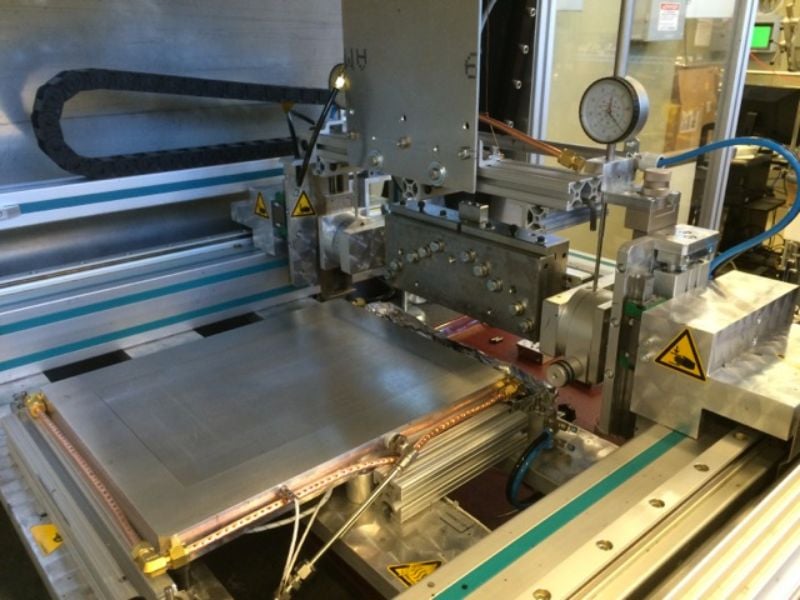Using Microgravity to Study Organic Solar Cell Efficiency
Organic photovoltaic cells are promising alternatives to conventional solar cells but lack efficiency. Experiments in microgravity could help engineers better understand the formation of organic photovoltaic cells.
In the search for sustainable and efficient renewable energy sources, organic photovoltaic (OPV) cells have emerged as a promising solution. OPVs, employing organic compounds, mark a departure from traditional inorganic materials like silicon, which is used in conventional solar cells. This innovative approach lends OPVs an array of advantageous properties—they are potentially more flexible, lightweight, and cost-effective in production.
Creating organic photovoltaic cells in a lab. Image used courtesy of NREL
However, like any emerging technology, OPVs face unresolved challenges before widespread adoption. Recently, researchers at Karlstad University analyzed the formation of OPVs in microgravity to get better insights into their fabrication.
Organic Photovoltaic Cells
Unlike traditional solar cells that use inorganic materials like silicon, OPVs utilize organic compounds, often carbon-based, making them potentially more flexible, lightweight, and less expensive to produce.
An OPV device. Image used courtesy of NREL
OPVs consist of a photoactive layer of organic semiconductors—typically polymers or small molecules. These materials can absorb sunlight and generate charge carriers (electrons and holes). The unique aspect of OPVs lies in their physical properties. Organic materials can be processed into thin films over large areas, offering the possibility of integrating solar cells into a variety of surfaces and materials. This flexibility opens up new applications, such as building-integrated photovoltaics, where solar cells are incorporated directly into building materials like windows or roofing.
Another major benefit of OPVs is the ability to print cells using roll-to-roll processes, similar to newspaper printing. This could significantly reduce manufacturing costs and increase the feasibility of large-scale production, making OPVs a potentially more accessible and versatile solution for renewable energy generation.
Organic Photovoltaic Challenges
Despite their potential, OPVs face several challenges that hinder their widespread adoption.
One primary issue is efficiency. Currently, the highest efficiency for OPVs is around 20%, which is lower compared to some inorganic photovoltaic technologies. Improving their efficiency is a key area of research, focusing on optimizing the photoactive materials and cell architecture.
Another significant challenge is longevity. OPVs degrade faster than inorganic solar cells, limiting their operational lifespan. This degradation is often due to environmental factors like oxygen and moisture. Developing more robust materials and protective coatings is crucial to enhancing their durability.
Finally, environmental and health concerns are associated with the solvents used in the production process of OPVs. Many solvents used in laboratory settings are halogenated and harmful, posing risks for large-scale manufacturing. Research is ongoing to find more environmentally friendly solvents that can be used safely and effectively in OPV production.
Organic Photovoltaic Efficiency Research
A recent Karlstad University study sought to improve the efficiency and sustainability of OPVs by investigating the active layer morphology in OPV cells, which plays a vital role in their efficiency.
A schematic showing the steps for generating photocells. Image used courtesy of the Swedish Research Council
The research takes an innovative approach to understanding and controlling this morphology at a molecular level. One of the primary methods involves using the Hansen solubility parameter model and solution chemistry. This approach systematically identifies more environmentally friendly solvents for specific polymer-polymer systems. This provides insights into the interaction parameters between the solvent and the solute and between different solutes.
Another area of focus in the study was solution chemistry and evaporation kinetics. To improve OPV cell performance, it’s essential to understand how the behavior of polymers in solution and the evaporation of solvents influence the morphology and photophysical properties of the thin film. To this end, researchers conducted groundbreaking experiments in microgravity environments to study early-stage phase separation between materials. In microgravity, phase separation processes are slowed down, offering unique insights into the development of the active layer's morphology. The team was able to film these processes in microgravity to better analyze the underlying processes.
OPV Research Importance
This research is important because it addresses the efficiency challenges of OPV cells by providing a better understanding of the factors that affect them at the molecular level. The innovative use of microgravity conditions for research represents a novel approach in materials science and may provide researchers with a new method to gain deeper insights into the formation of OPVs and how to influence their efficiency.









